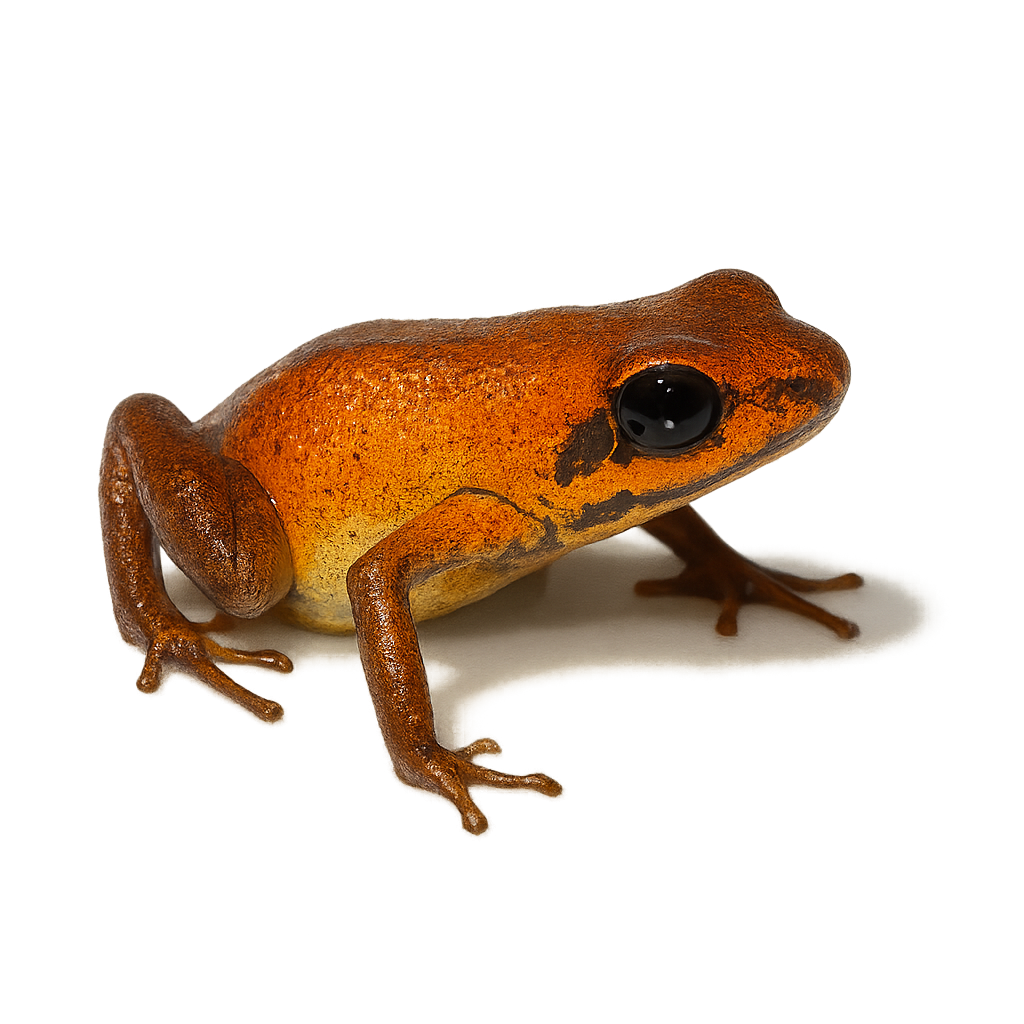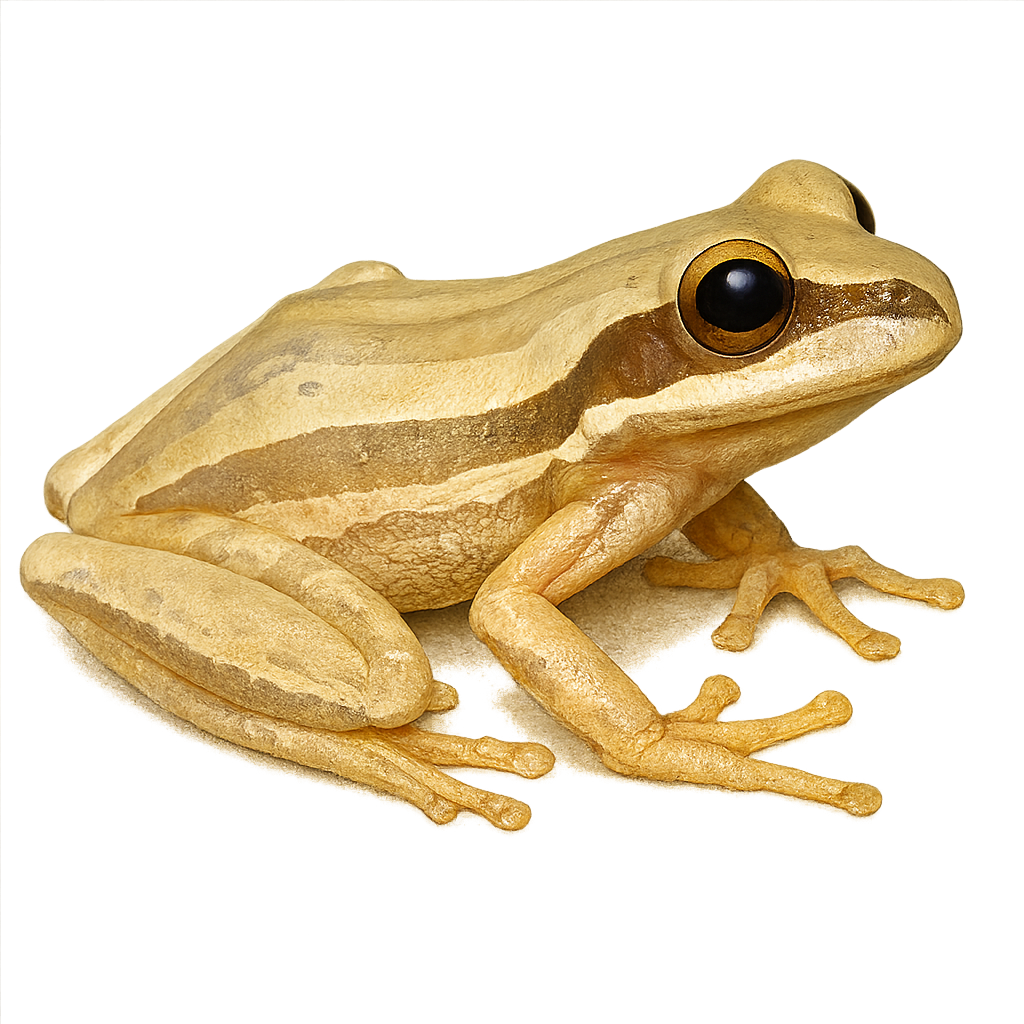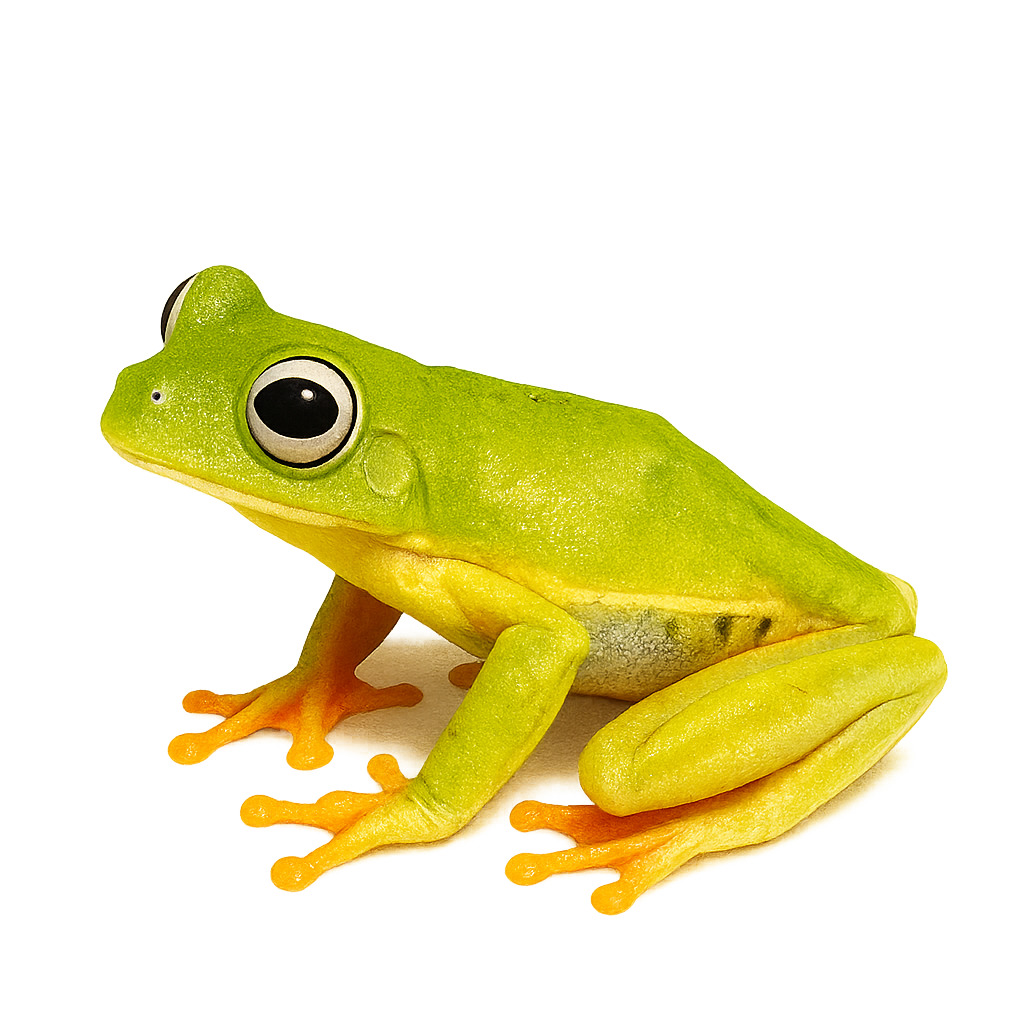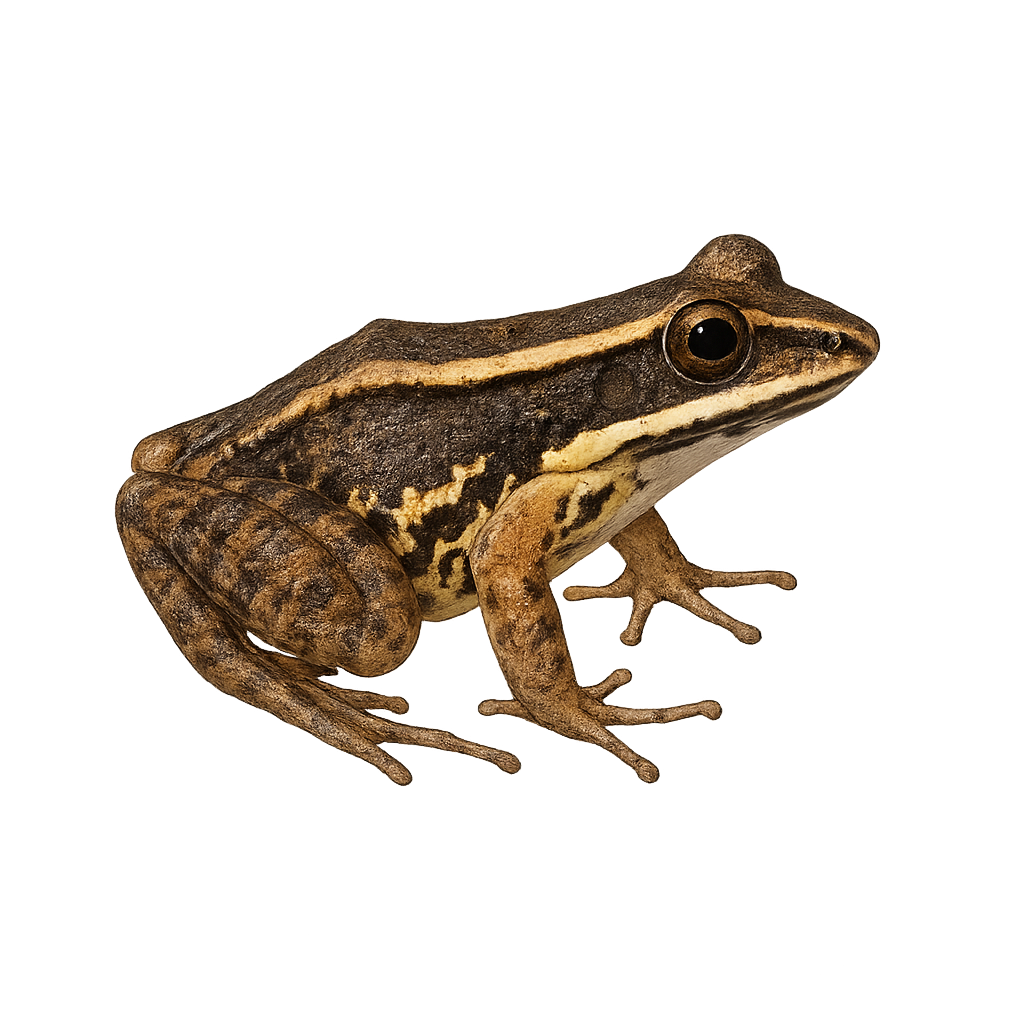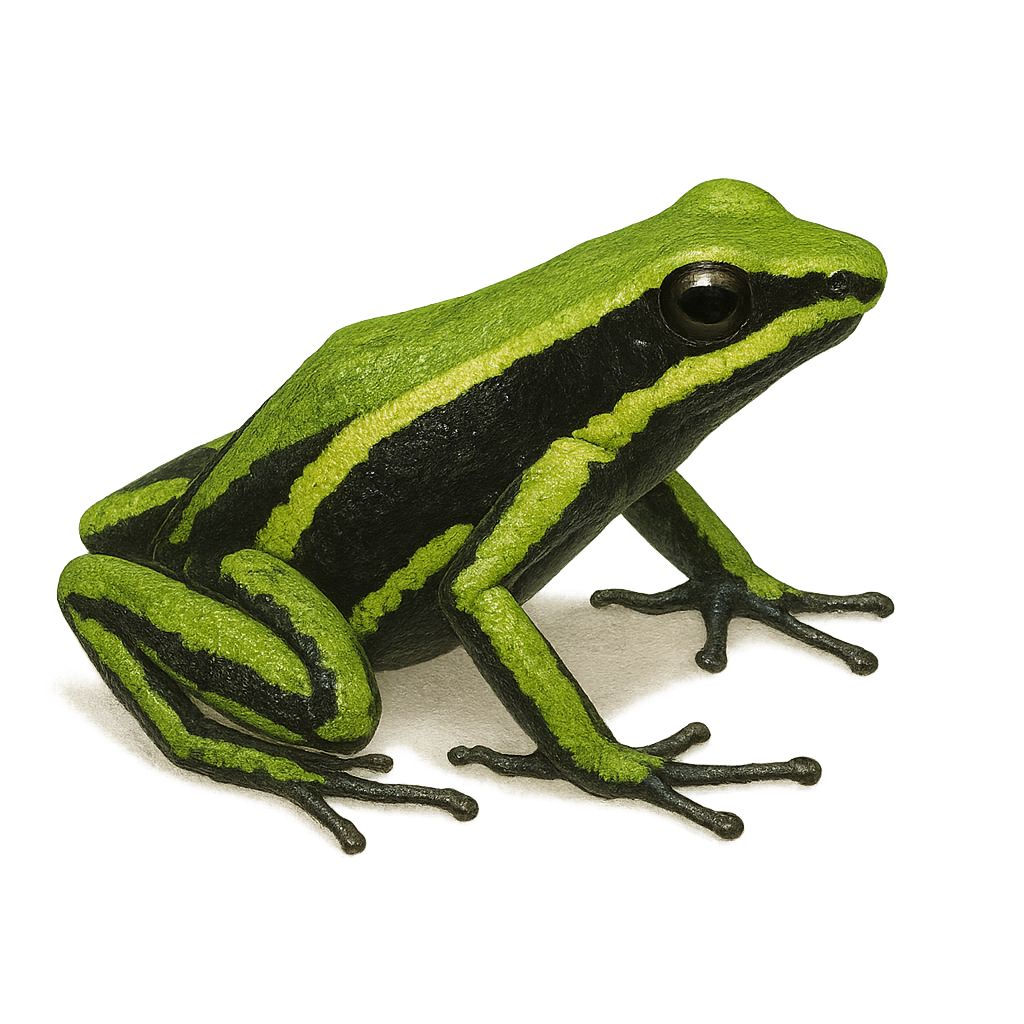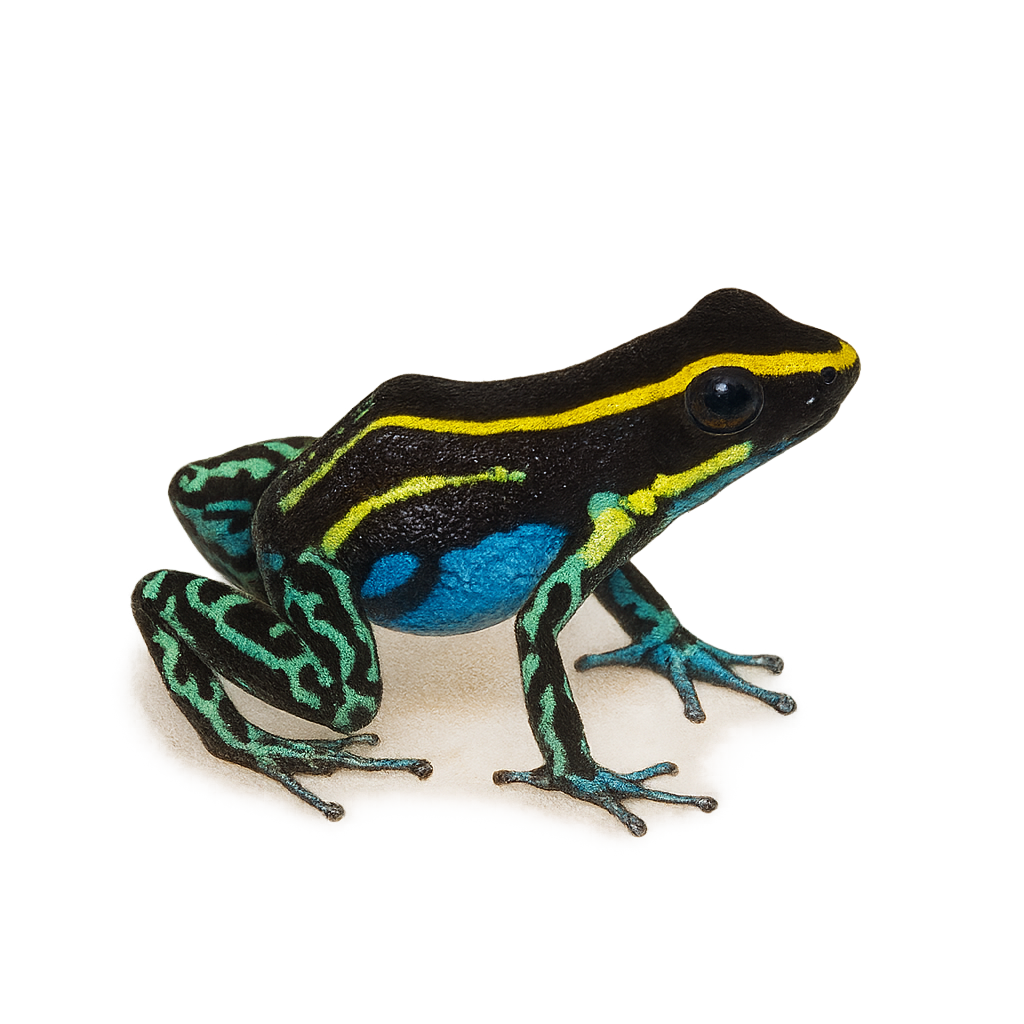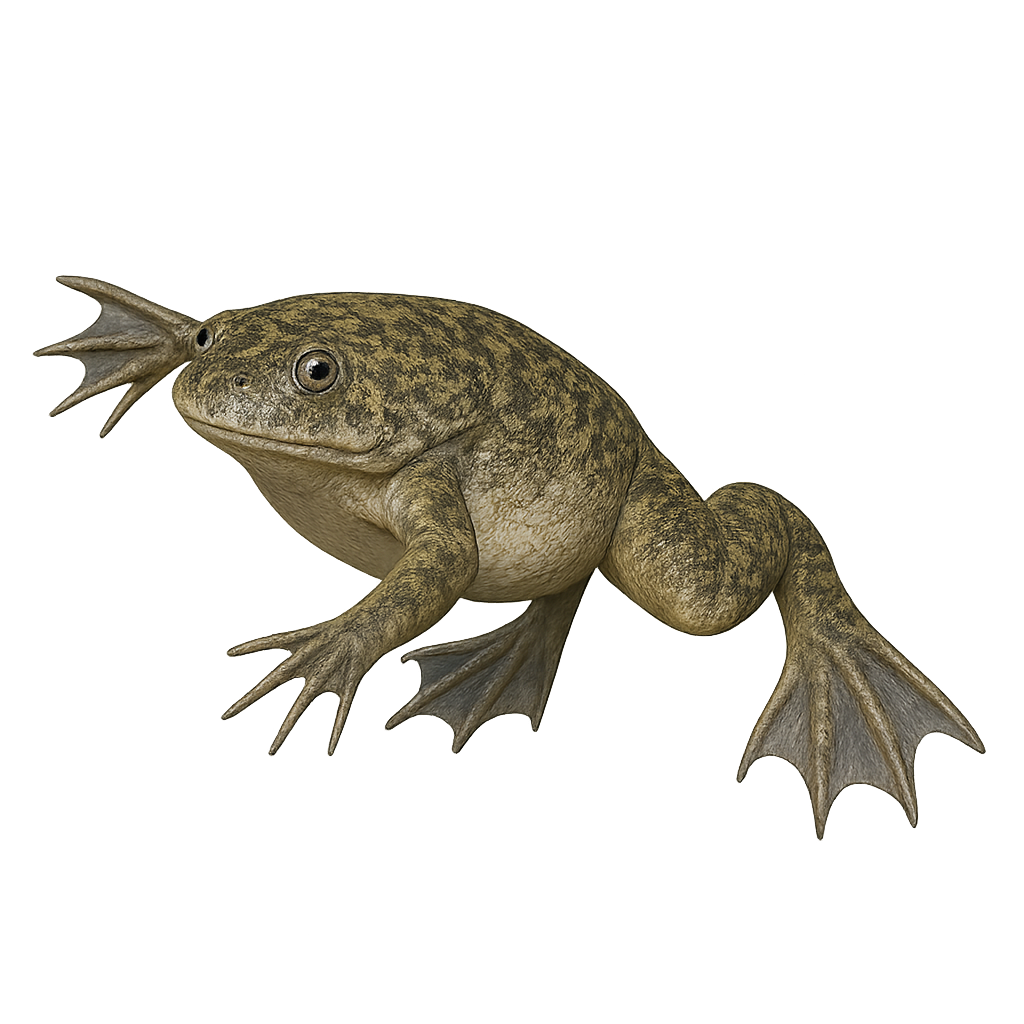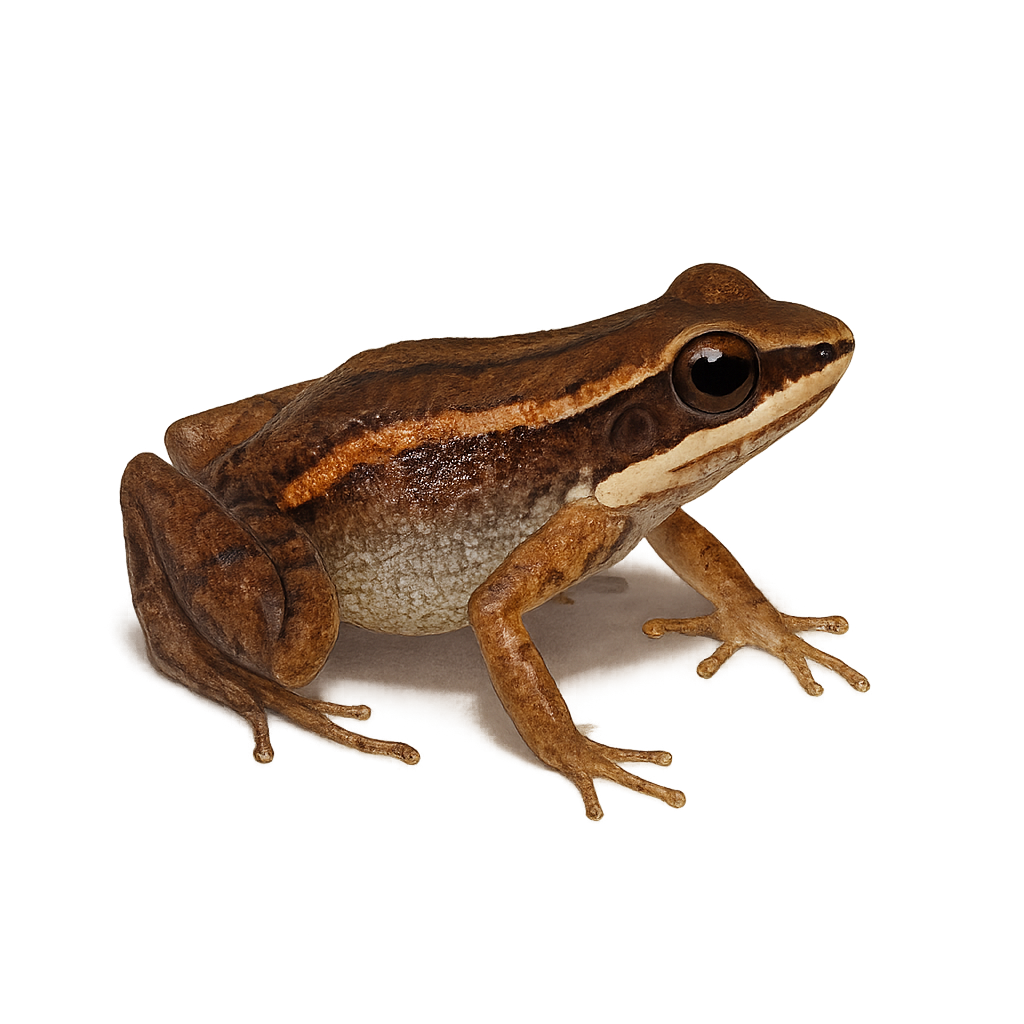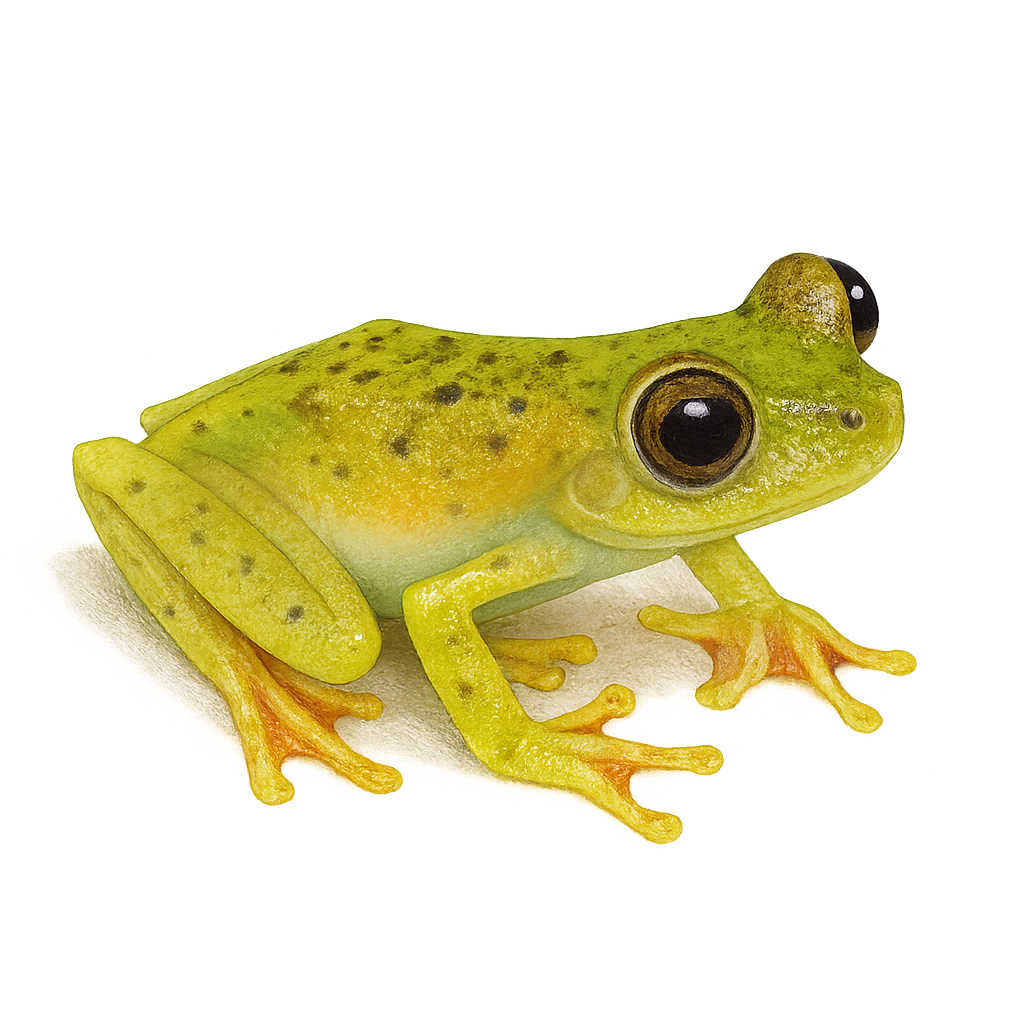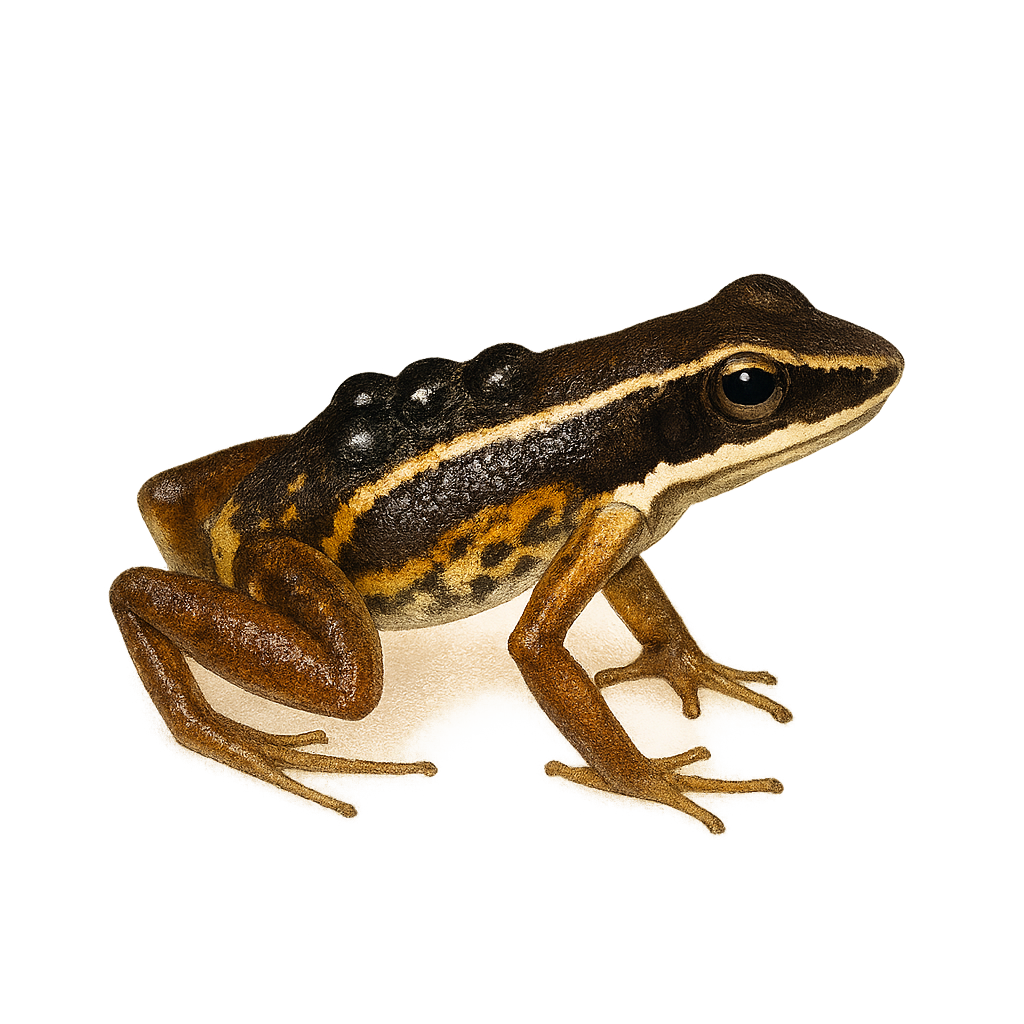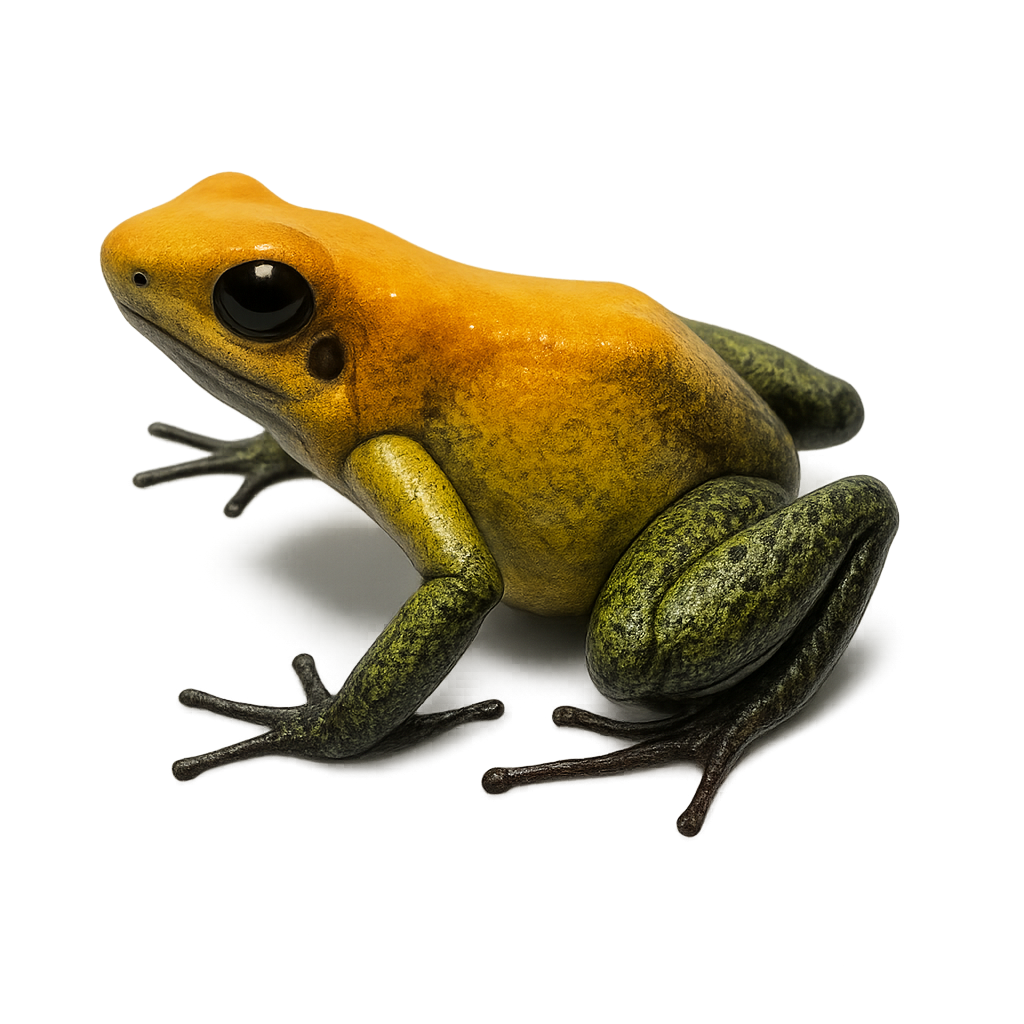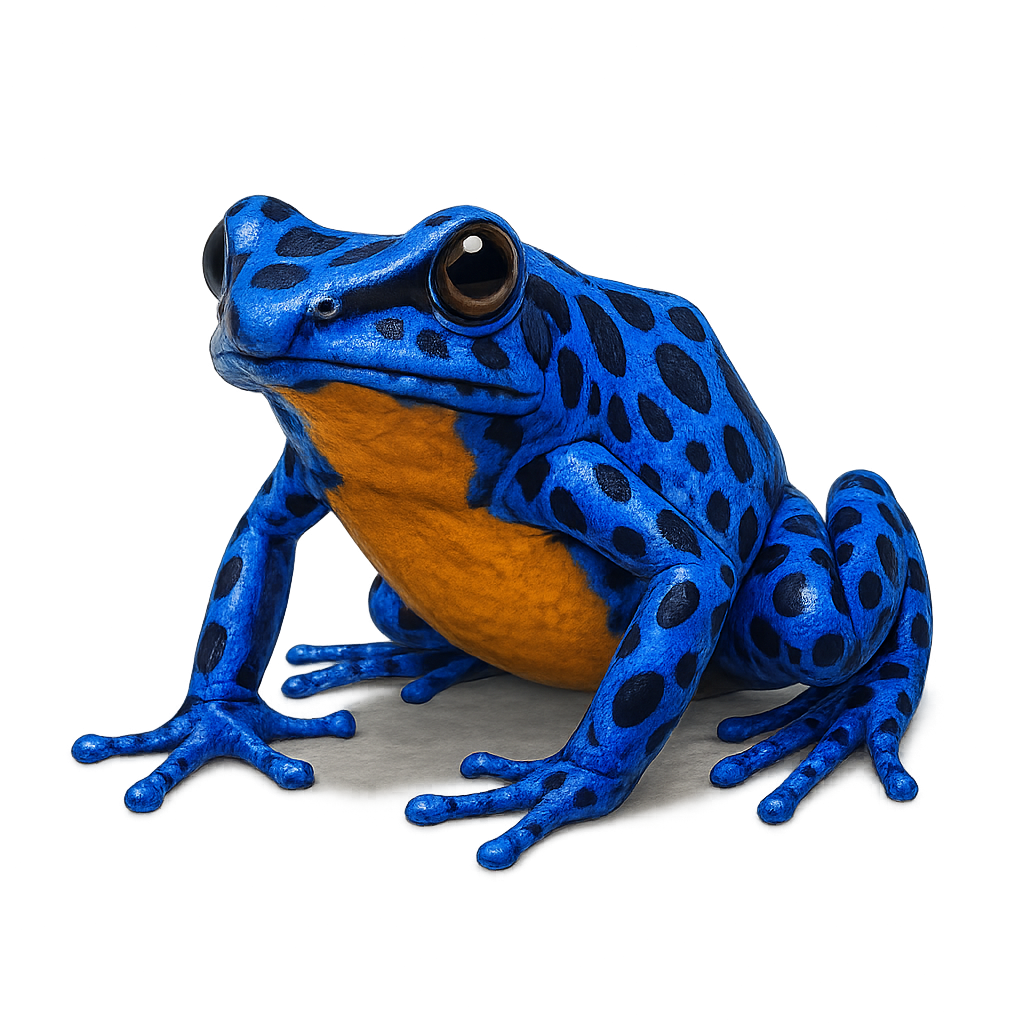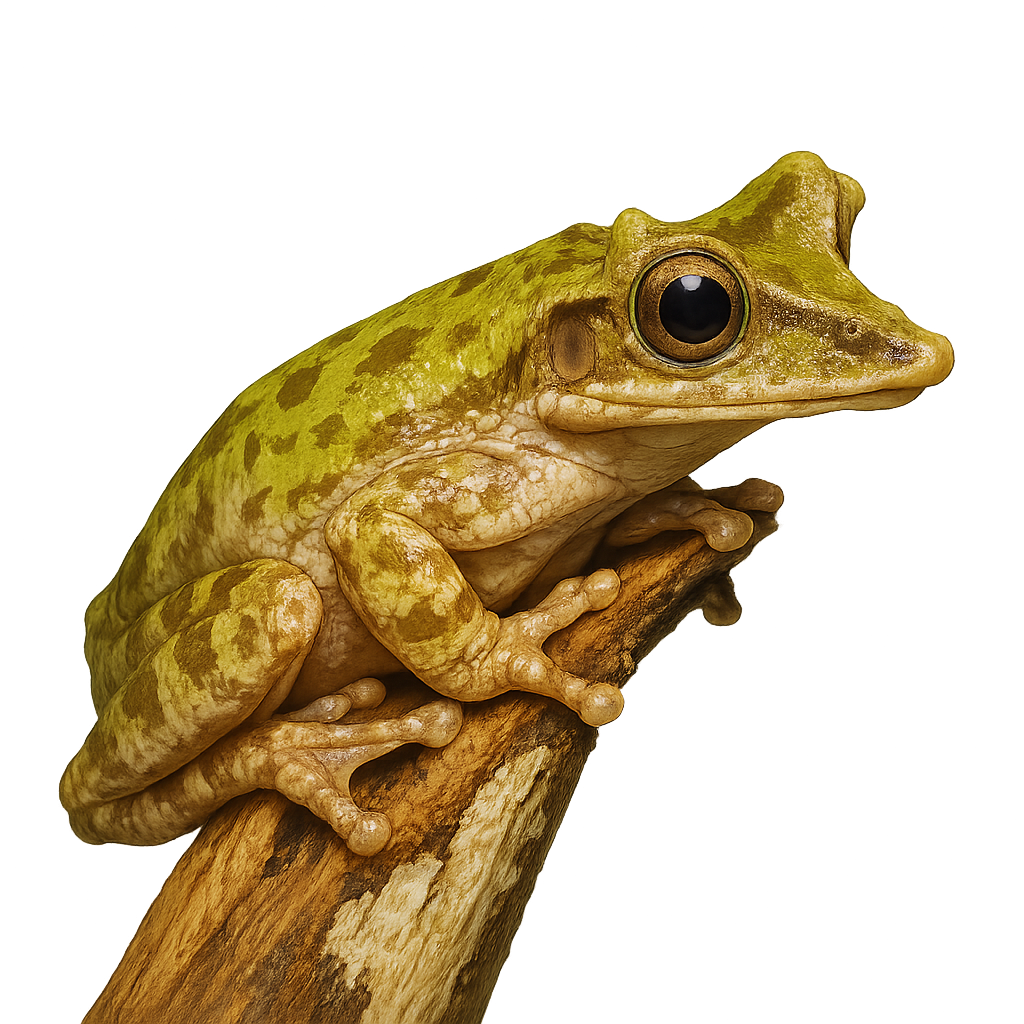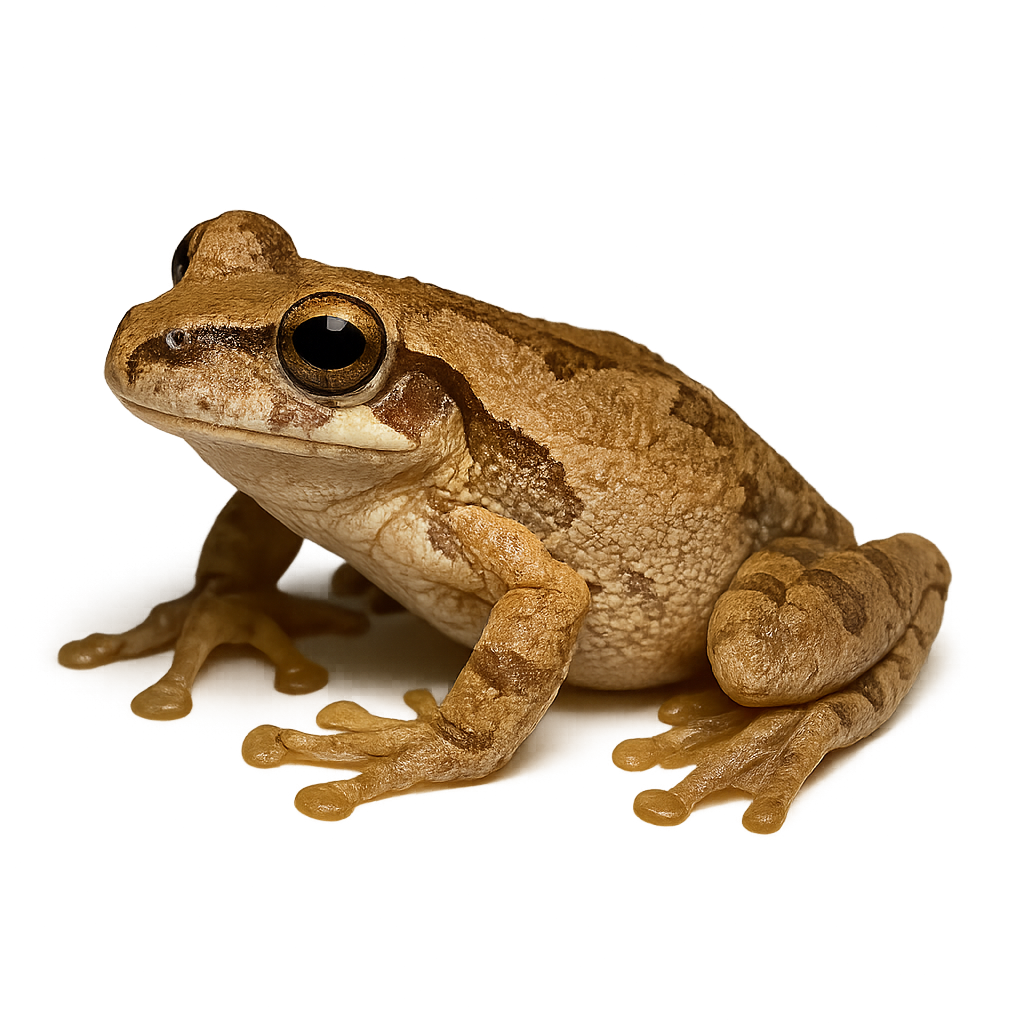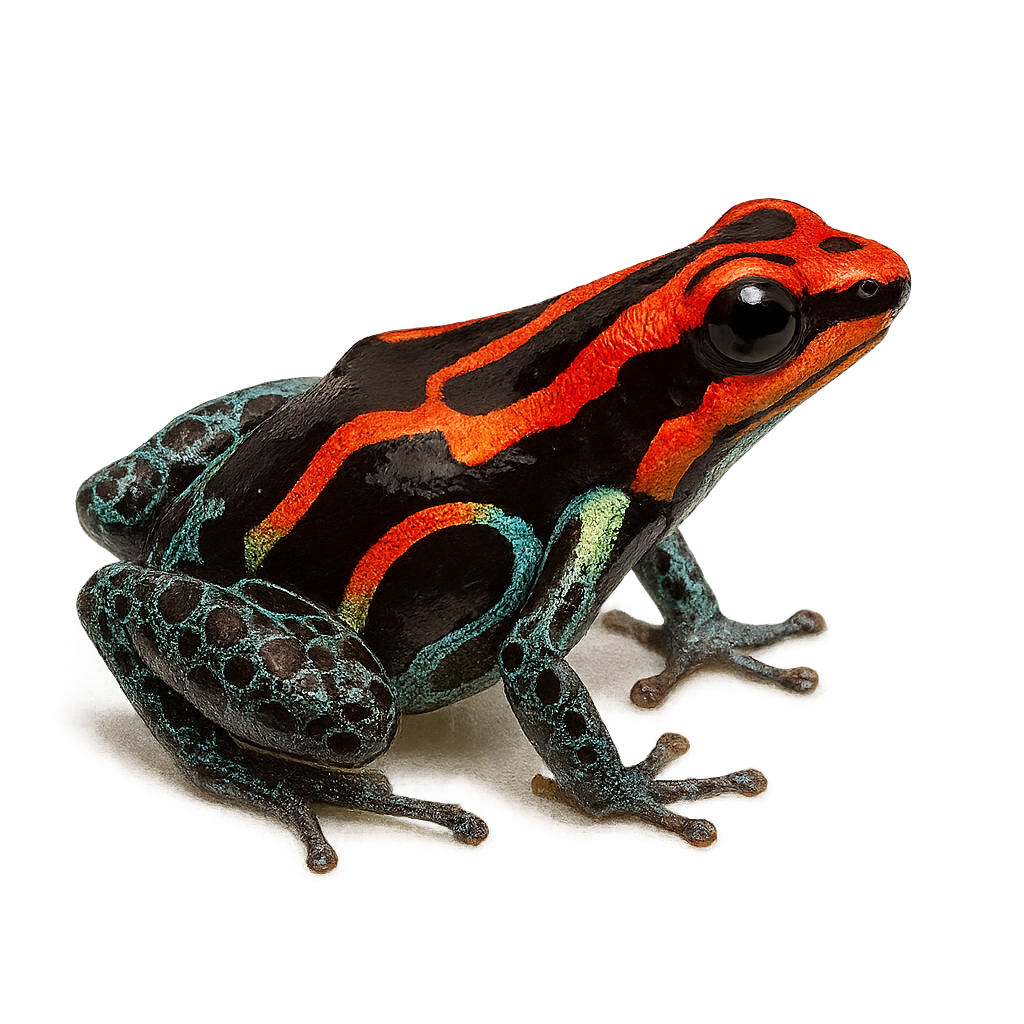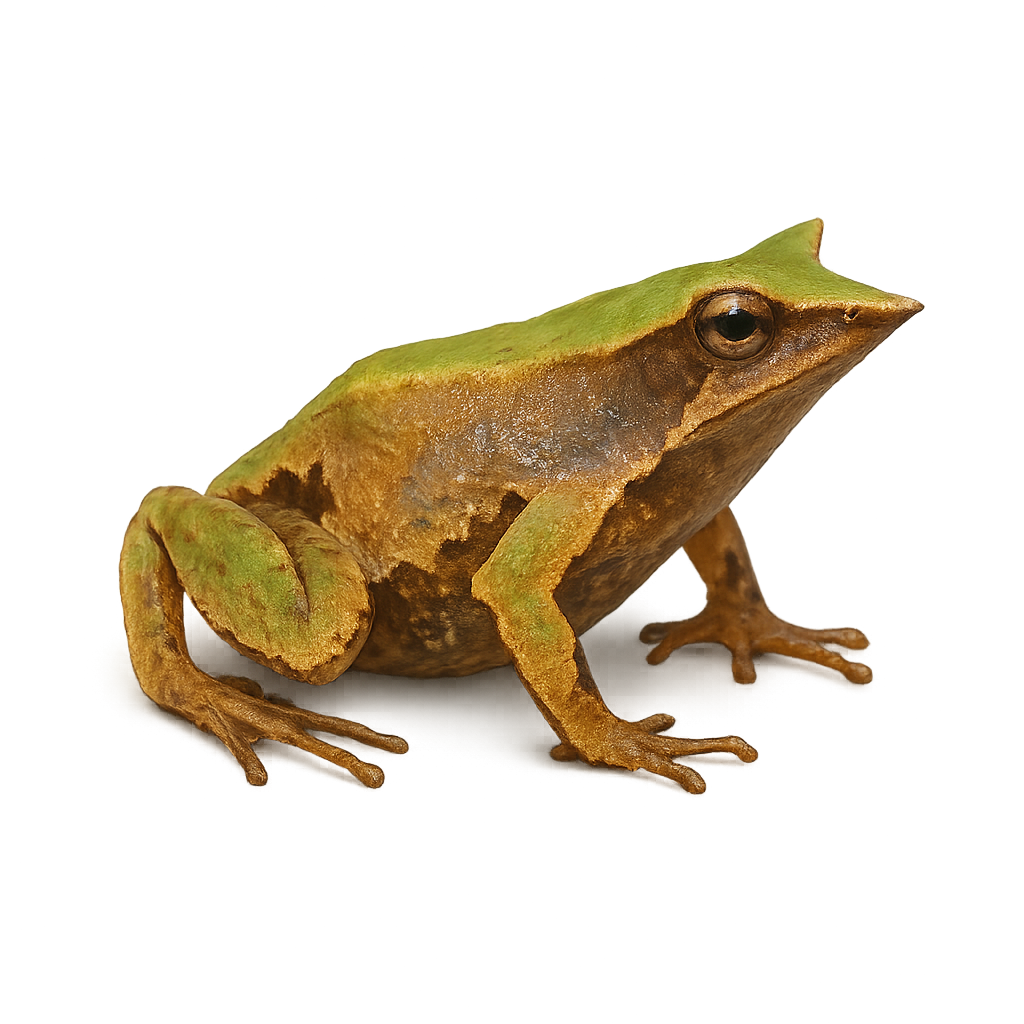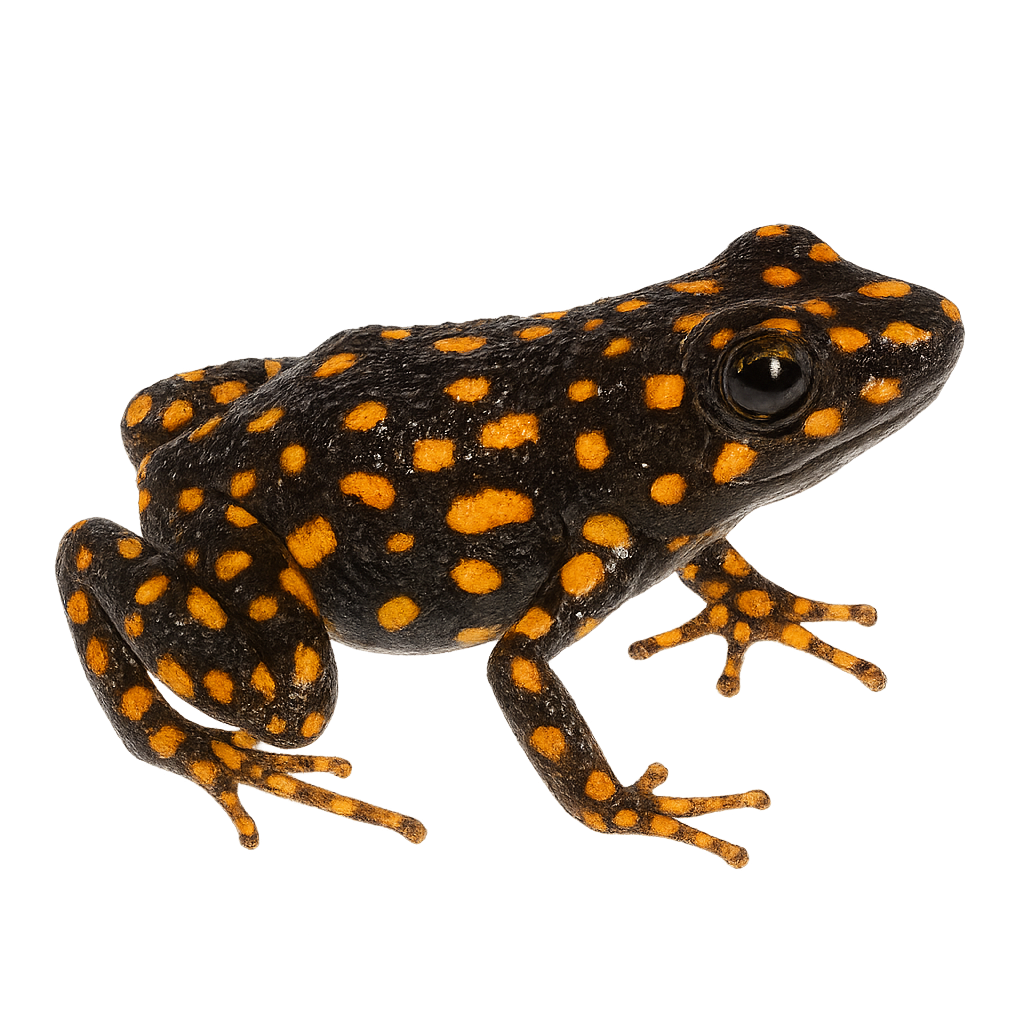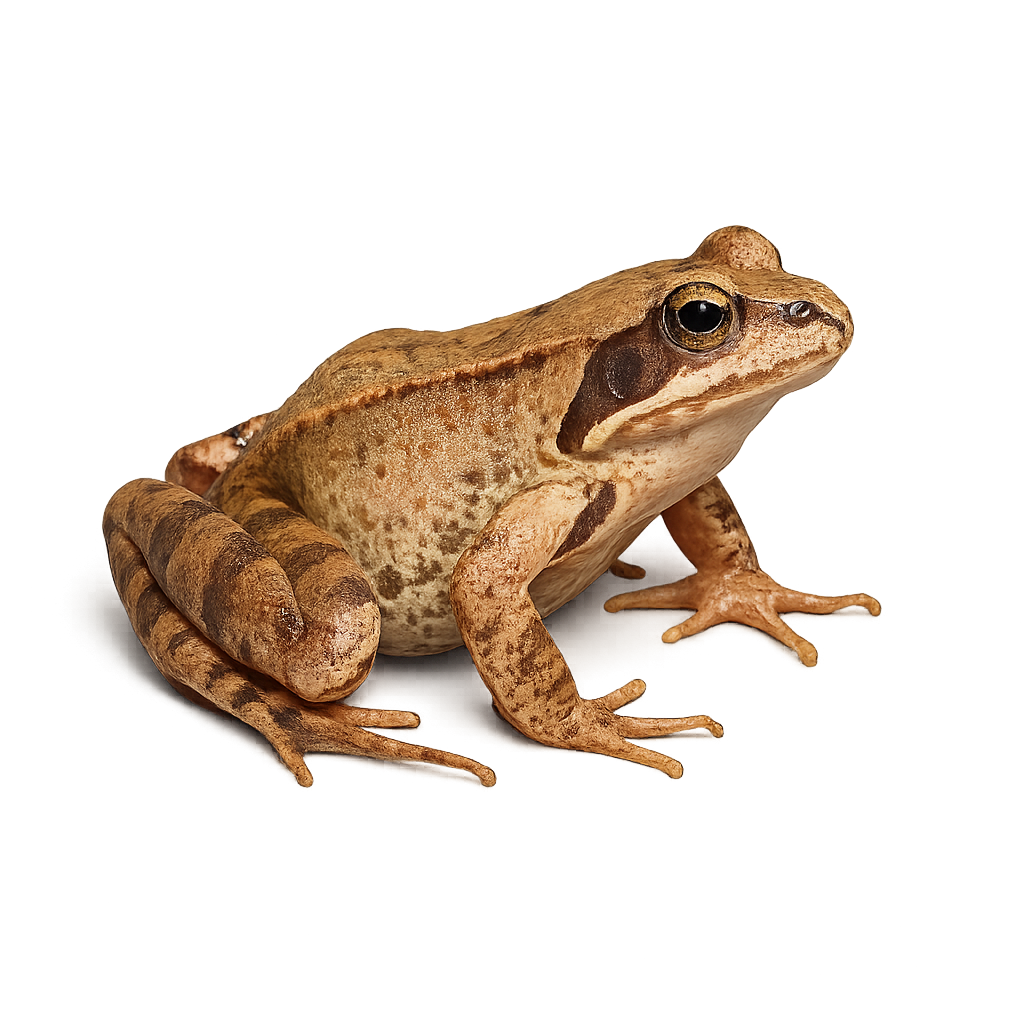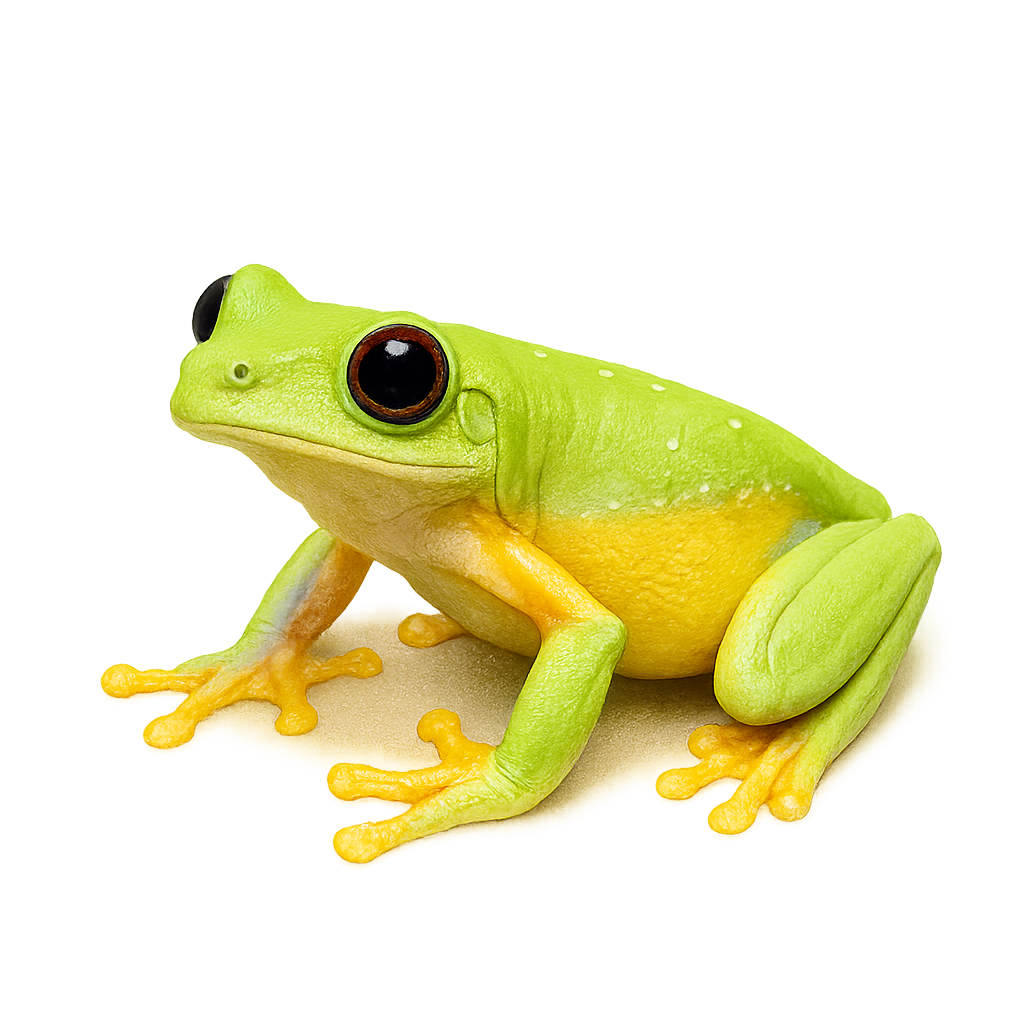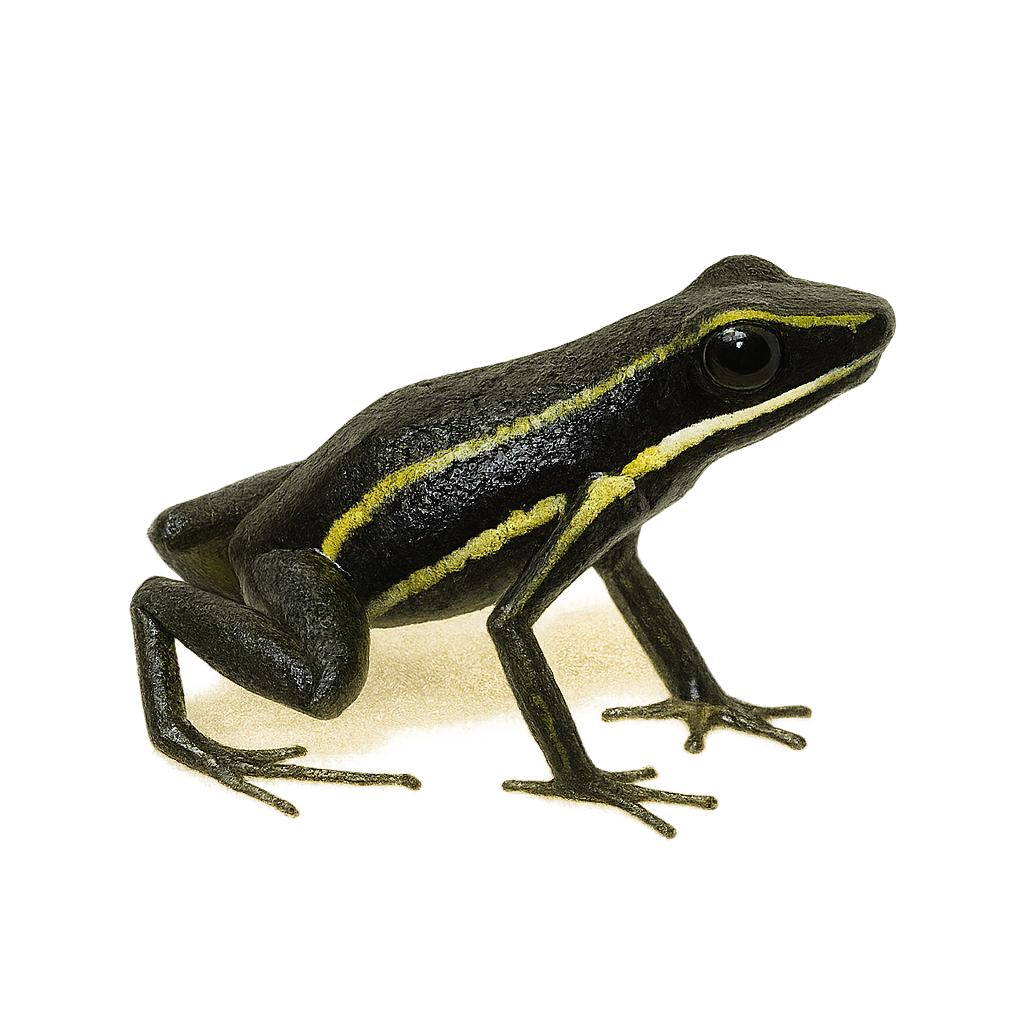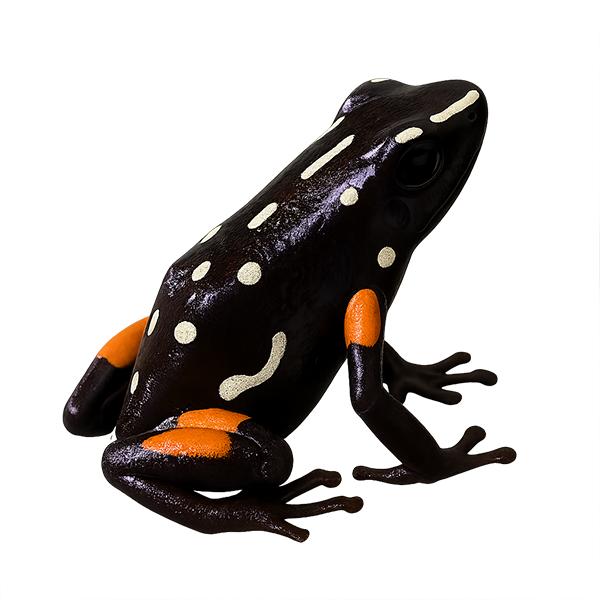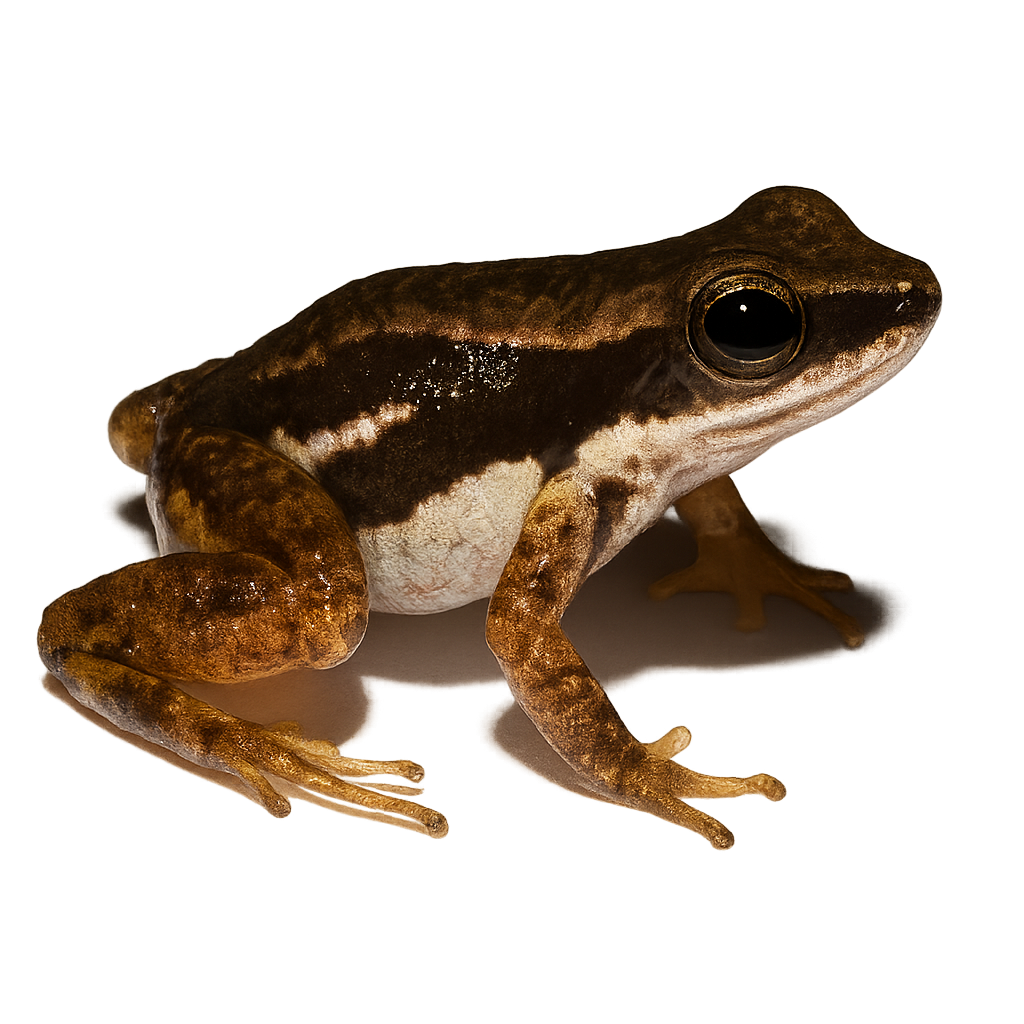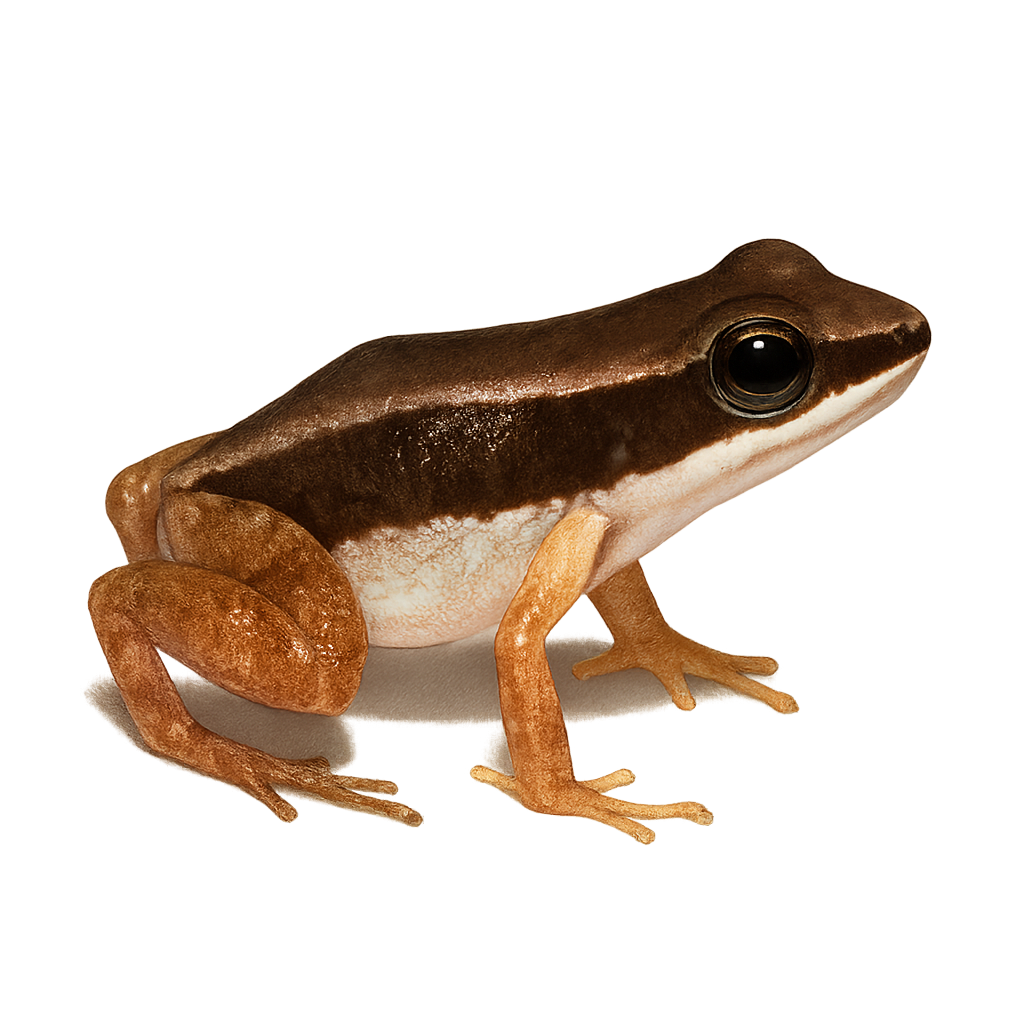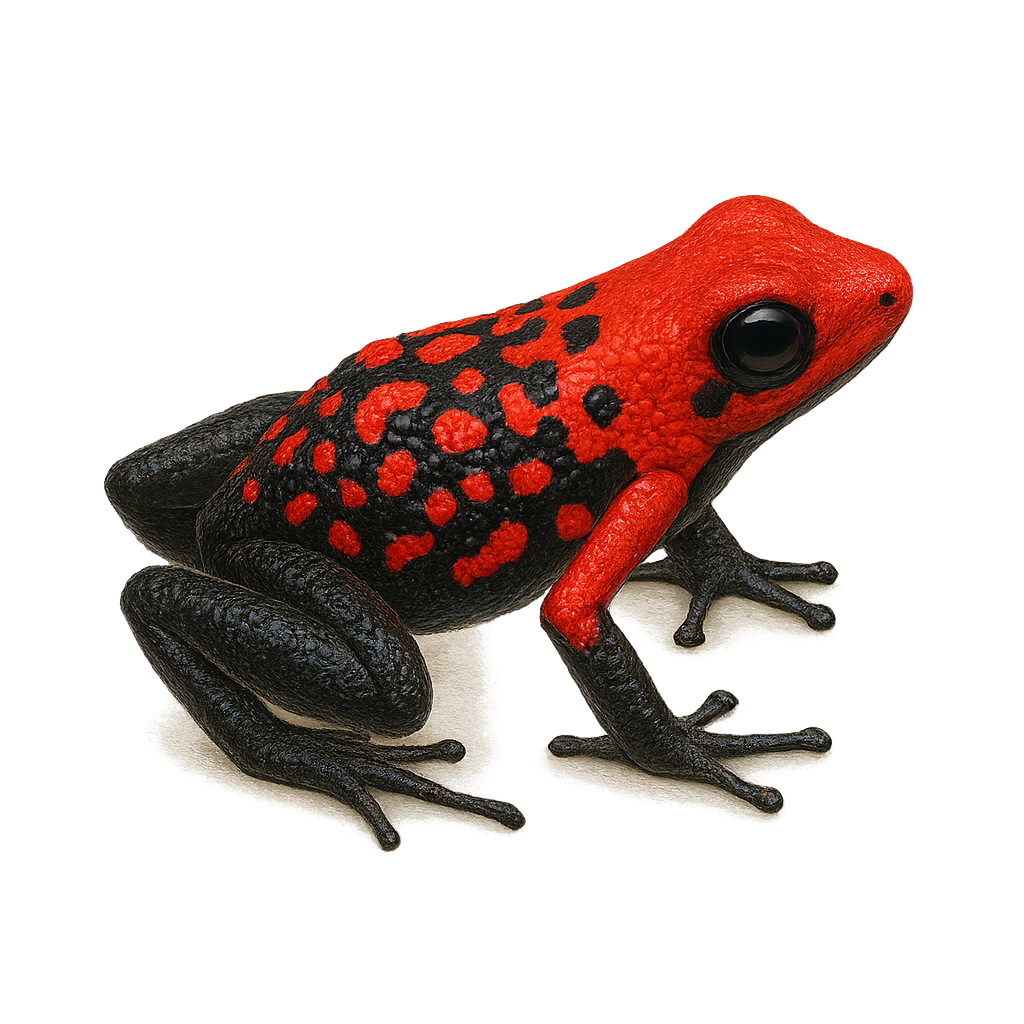The Geminis’ dart frog, Andinobates geminisae, is a small, brightly colored frog native to the humid rainforests of Panama. Recently discovered, it is distinguished by its vivid orange color and small size, measuring about 1.5 cm. This species primarily inhabits leaf litter and moist forest areas, feeding on small invertebrates. Like other poison frogs, it is known for its toxic skin, a defense against predators. Reproduction involves laying eggs in moist spots, with notable parental care where adults transport tadpoles to water bodies. This species is currently classified as vulnerable due to habitat loss and collection for the pet trade.
Boana latistriata, commonly known as the Cope's Eastern Paraguay Treefrog, is a species of amphibian in the Hylidae family. It is primarily found in the humid tropical forests of South America, particularly in Brazil. This frog is distinguished by its broad, dark lateral stripes that contrast with its green skin. It is generally nocturnal, feeding on insects and other small invertebrates. Its ability to adhere to vertical surfaces with its adhesive toes allows it to move easily in its arboreal habitat. Although its conservation status is concerning, it is still relatively widespread in some areas.
The White-edged Tree Frog, Boana albomarginata, is a species of tree frog found mainly in the humid tropical forests of South America. It is recognizable by its bright green coloration and distinctive white edges along its limbs and body. This species is generally active at night, feeding on insects and other small invertebrates. It prefers habitats near water bodies, where it can easily reproduce. Males call to attract females during the rainy season. Although this species is not currently threatened, deforestation and habitat loss pose potential risks to its population.
The Mantidactylus femoralis is a frog species endemic to Madagascar, predominantly found in the island's humid tropical forests. It is identifiable by its robust thighs and brown coloration, which allows it to blend into its natural surroundings. This medium-sized frog has smooth skin and subtle patterns that vary slightly among individuals. It plays a crucial role in the ecosystem as an insect predator, helping to regulate invertebrate populations. Although its habitat is threatened by deforestation, it remains relatively widespread in protected areas. Its ability to adapt to different microhabitats provides it with a survival advantage.
The Granular Poison Frog, Oophaga granulifera, is a brightly colored and toxic frog species native to the humid tropical forests of Costa Rica and Panama. It is easily recognizable by its vivid, granular skin, typically bright red with black spots. This coloration serves as a warning to potential predators of its toxicity. Measuring about 2 to 3 centimeters, this frog is a fascinating example of aposematic mimicry. It primarily feeds on small insects and arthropods found in the leaf litter. The Granular Poison Frog plays a crucial role in its ecosystem by controlling insect populations and serving as prey for certain predators resistant to its poison.
Ameerega trivittata is a colorful and toxic frog native to the humid tropical forests of South America. It is distinguished by its longitudinal yellow or green stripes on a black background, serving as a warning to potential predators. This species is diurnal and primarily feeds on small insects. It is often observed on the forest floor, using its bright colors to deter predators. The three-striped poison frog plays a crucial role in the ecosystem by regulating insect populations. Although its skin is toxic, it is not dangerous to humans unless handled directly.
The Sky‑blue poison frog, Hyloxalus azureiventris, is a small, brightly colored frog native to the humid tropical forests of Peru. It is characterized by its vivid coloration, with a brown back and a striking blue belly, allowing it to blend in with fallen leaves and streams. Measuring about 2 to 3 cm, it is primarily terrestrial and feeds on small insects. This species is known for its territorial behavior, with males actively defending their territory against intruders. The Blue-bellied Poison Frog plays a crucial role in the ecosystem by regulating insect populations and serving as prey for many predators.
Xenopus laevis is a fully aquatic amphibian native to sub-Saharan Africa, identifiable by its smooth olive skin and four claws on the front feet. It inhabits ponds, pools, and ditches of still water, feeding on invertebrates and small fish with its fast, sticky tongue.
The Finca Primavera rocket frog, scientifically known as Colostethus alacris, is a small, vibrant frog species native to the humid tropical forests of South America. It is primarily found in the mountainous regions of Colombia, where it inhabits leaf litter and areas near water streams. Its coloration ranges from brown to green, with distinctive patterns that allow it to blend effectively into its natural surroundings. This species is known for its distinctive call, used by males to attract females during the breeding season. Although its conservation status is currently concerning due to deforestation and habitat loss, it continues to fascinate herpetologists and nature enthusiasts with its unique behavior and ecology.
The Polkadot poison frog, scientifically known as Oophaga arborea, is a fascinating species from the Dendrobatidae family. It is primarily known for its bright coloration and distinctive patterns, which serve as a warning to potential predators. This frog is endemic to the humid tropical forests of Central America, where it primarily inhabits trees and shrubs. It is diurnal, meaning it is active during the day, and feeds mainly on small insects. Its skin secretes powerful toxins, a common trait among frogs of this family. Preserving its natural habitat is crucial for its survival, as it is sensitive to environmental changes.
Boana rufitela is a tree frog known for its distinctive red spots on a bright green background, allowing it to blend seamlessly into its natural habitat. It is primarily found in the humid tropical forests of South America, where it resides in the tree canopy. This species is nocturnal, meaning it is mostly active at night, feeding on insects and other small invertebrates. Its skin is slightly toxic, serving as a defense mechanism against predators. The Boana rufitela plays a crucial role in the ecosystem by regulating insect populations and serving as prey for other animals. Although its population is stable, deforestation poses a potential threat to its habitat.
The Oophagous Slender-legged Treefrog, or Osteocephalus oophagus, is a fascinating species of tree frog primarily found in the humid tropical forests of South America. It is particularly notable for its unique reproductive behavior: females lay their eggs in water-filled tree cavities, and the tadpoles feed on unfertilized eggs that the mother regularly deposits. This feeding strategy, known as oophagy, is rare among amphibians and allows the tadpoles to survive in environments where food is limited. The Oophagous Slender-legged Treefrog is medium-sized, with smooth skin and color patterns that allow it to effectively camouflage in its natural habitat. It plays a crucial role in the ecosystem as an insect predator, helping to regulate invertebrate populations.
Hyloxalus abditaurantius is a small, brightly colored frog native to the humid tropical forests of South America, primarily in Ecuador. It is distinguished by its vivid coloration, often with shades of orange and brown, allowing it to blend effectively into its natural habitat. This species is typically found near streams and wetlands, where it primarily feeds on insects. Although discreet, it plays an essential role in the ecosystem by regulating insect populations. Its reproduction usually occurs during the rainy season when conditions are ideal for tadpole development.
The Phyllobates bicolor, or bicolored poison dart frog, is a venomous frog species native to the humid rainforests of Colombia. Known for its smooth, shiny skin, it often displays bright yellow with shades of green or blue. This vivid coloration serves as a warning to potential predators of its toxicity. Indeed, Phyllobates bicolor secretes a powerful toxin, batrachotoxin, which can be lethal. It typically measures between 3 and 4.5 cm in length. This species is diurnal and primarily feeds on small insects. It plays a crucial role in its ecosystem by regulating insect populations. Unfortunately, habitat destruction poses a threat to its survival.
The Azureus Poison Dart Frog is a brightly colored and striking species, known for its vivid blue color that varies in intensity. Native to the humid tropical forests of Guyana, Suriname, and Brazil, it is famous for its camouflage abilities and skin glands that secrete potent toxins, used for defense against predators. This frog is primarily terrestrial and lives in areas near streams and swamps, where it feeds on insects and other small prey. Due to its coloration, it serves as a warning signal to predators. It is primarily diurnal.
The Helmeted Tree Frog is a fascinating amphibian species, known for the distinctive helmet-like protuberance on its head. This protuberance, resembling a helmet, helps it camouflage among the leaves and branches of trees in the humid tropical forests. It is mainly found in the forests of Costa Rica, Panama, and Nicaragua. It is nocturnal and terrestrial, spending much of its time in the canopy near streams where it lays its eggs. This frog is rather discreet and often hides in dense vegetation to avoid predators.
The Anchicayé Poison Frog, Oophaga anchicayensis, is a species of frog endemic to the humid tropical forests of Colombia. Known for its bright coloration, ranging from red to blue, it serves as a warning signal to potential predators. This small frog typically measures between 2 and 3 cm in length and feeds primarily on small insects and arthropods. Like other members of the Dendrobatidae family, it possesses potent skin toxins used as a defense mechanism. The Anchicayé Poison Frog is often found in moist undergrowth, moving slowly in search of food. Its reproduction is complex, involving the transport of tadpoles by parents to suitable aquatic sites.
Baudin's Tree Frog is a fascinating amphibian species, often found in the humid tropical forests of Central America, primarily in Mexico, Costa Rica, and Guatemala. It is easily recognized by its bright coloration, which ranges from light green to yellow, with distinct patterns on the legs and back. This frog is semi-arboreal, meaning it spends part of its time on trees and bushes, near stagnant waters or streams. It is nocturnal and uses its coloration to blend into its environment when resting. It is also capable of making long leaps to escape predators.
The Cochranella Frog is a fascinating amphibian species, known for its translucent skin that allows its internal organs to be visible. Unlike other glass frogs, its skin is slightly granular, which helps it camouflage better in the dense vegetation of its habitat. This frog lives in the humid tropical forests of Central America, mainly in Costa Rica and Panama, where it is found on leaves hanging above streams. Its small size, combined with its discreet behavior, makes it hard to spot. The eggs are laid on leaves above the water, and the tadpoles fall into the stream as they hatch. These frogs are primarily nocturnal and prefer to avoid human interaction.
The Silverstoneia dalyi, commonly known as Daly's Rocket Frog, is a small, brightly colored frog native to the humid rainforests of South America, particularly Colombia. It is characterized by its small size, usually less than 2 cm, and its vibrant color patterns ranging from brown to green with black markings. This species is often found near streams where it breeds. Although discreet, it plays a crucial role in the ecosystem as an insect predator. Its skin secretes toxic substances to defend against predators. Daly's Rocket Frog is an important indicator of habitat health, as it is sensitive to environmental changes.
Darwin's frog is a unique species discovered in Chile and Argentina, famous for its unusual reproductive behavior. After fertilization, males carry the eggs in their mouths until the tadpoles develop into small frogs. They are small in size, brown or green in color, and live in temperate forests, feeding on insects and small invertebrates. The species is threatened by habitat loss and pollution.
The Darwin Wallace poison‑frog, Epipedobates darwinwallacei, is a fascinating species from the Dendrobatidae family. It is endemic to the humid tropical forests of Ecuador, primarily inhabiting lush undergrowth. This frog is distinguished by its bright colors and complex patterns, which serve to warn predators of its toxicity. It typically measures between 20 and 25 mm in length, making it a small species. Its distinctive call is often heard during the rainy season, when it is most active. The Darwin Wallace poison‑frog plays a crucial role in the ecosystem by regulating insect populations and serving as a bioindicator of environmental health.
Fitzinger's Rain Frog is a terrestrial amphibian species found in the humid tropical forests of Central America, mainly in Costa Rica and Panama. It is known for its rough skin and typically gray-brown coloration, which helps it blend seamlessly into its environment. This frog is nocturnal and prefers to live in damp understory areas, where it hides under dead leaves or rocks. Its small size, combined with its discreet behavior, makes it hard to spot. Unlike other tree frogs, it is primarily terrestrial and spends most of its time on the ground, near temporary water sources where it lays its eggs.
The agile frog is a small terrestrial frog of 6–8 cm with light brownish-red dorsal coloration and pale throat, equipped with strong hind legs. It inhabits open woodland edges, damp meadows and hedgerows, feeding on insects and spiders. During the breeding season, males call from the water’s edge to attract females into shallow water.
The Morelet's Tree Frog, scientifically known as Agalychnis moreletii, is a striking species of arboreal frog characterized by its smooth skin and vibrant colors. It features a bright green back and a white belly, with prominent red or orange eyes. This nocturnal frog is found in the humid tropical forests of Central America, particularly in Mexico, Belize, and Guatemala. It is often seen perched on tree branches near water bodies, where it breeds. The Morelet's Tree Frog is an endangered species due to habitat loss and water pollution. It plays a crucial role in the ecosystem by controlling insect populations.
The Nariño Poison Frog, or Epipedobates narinensis, is a brightly colored and toxic frog species native to the humid rainforests of Colombia. Known for its vivid skin and distinctive patterns, it serves as a warning to potential predators. This frog typically measures between 2 and 3 cm in length. It is notable for its ability to secrete toxic alkaloids through its skin, a feature that protects it from predators. It primarily inhabits dense, humid undergrowth, where it feeds on small insects. The Nariño Poison Frog plays a crucial role in the ecosystem by regulating insect populations and serving as a bioindicator of habitat health.
The Brazil-nut poison frog, or Adelphobates castaneoticus, is a small, brightly colored frog native to the humid tropical forests of Brazil. It is known for its smooth, shiny skin, featuring shades of brown and black, often with distinctive patterns that serve as camouflage. This diurnal species primarily feeds on small insects and arthropods. It plays a crucial role in the ecosystem by regulating insect populations. Although its skin contains toxic alkaloids, it is not dangerous to humans unless ingested. Unfortunately, deforestation threatens its natural habitat, leading to a decline in its population.
The Panamanian Rocket Frog, scientifically known as Colostethus panamansis, is a small amphibian species primarily found in the humid tropical forests of Panama. It is characterized by its smooth skin and vibrant colors, often a mix of brown and green, which allow it to effectively camouflage in its natural environment. This species is known for its distinctive calls, used by males to attract females during the breeding season. It prefers habitats close to water streams, where it can find its diet mainly consisting of insects. Although its conservation status is not alarming, deforestation and water pollution pose potential threats to its survival.
The Pratt's Rocket Frog, scientifically known as Colostethus pratti, is a fascinating species from the Dendrobatidae family. It is primarily found in the humid tropical forests of Central and South America, particularly in Colombia and Panama. This small frog is usually brownish with lighter patterns on its back, allowing it to blend effectively into its natural surroundings. It is known for its high-pitched, repetitive calls, often heard during the rainy season. Although discreet, it plays a crucial role in the ecosystem as an insect predator. Its conservation is essential, as it is sensitive to environmental changes and deforestation.
The Ameerega silverstonei, commonly known as Silverstone's Poison Frog, is a captivating species from the Dendrobatidae family. It is renowned for its vibrant colors, typically a mix of blue and black with distinctive patterns, which serve as a warning to potential predators of its toxicity. Native to the humid tropical forests of Peru, this frog prefers habitats rich in vegetation where it can hide and feed on insects. It is diurnal, meaning it is active during the day. Although its conservation status is not critical, deforestation and habitat loss pose potential threats to its survival.


